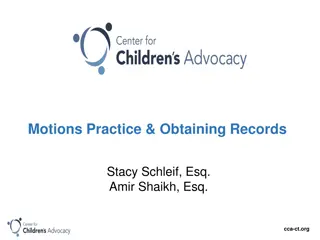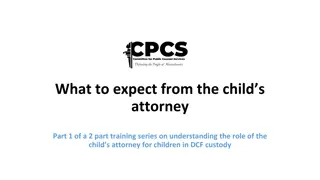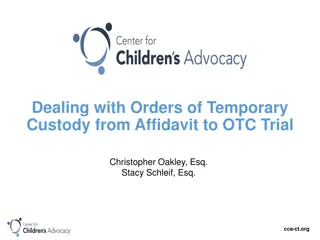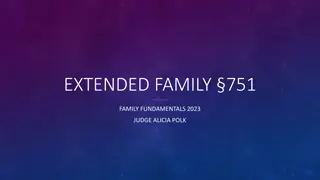
Navigating Child Custody Laws in Toronto: Key Considerations
Child custody in Ontario, under the Children's Law Reform Act, defines legal and physical custody based on the child's best interests. Custody can be sole, joint, shared, or split, focusing on stability, parental capacity, and emotional ties. Visit D
Download Presentation

Please find below an Image/Link to download the presentation.
The content on the website is provided AS IS for your information and personal use only. It may not be sold, licensed, or shared on other websites without obtaining consent from the author. If you encounter any issues during the download, it is possible that the publisher has removed the file from their server.
You are allowed to download the files provided on this website for personal or commercial use, subject to the condition that they are used lawfully. All files are the property of their respective owners.
The content on the website is provided AS IS for your information and personal use only. It may not be sold, licensed, or shared on other websites without obtaining consent from the author.
E N D
Presentation Transcript
2025 Navigating Child Custody Laws in Toronto: Key Considerations DivorceGO.ca
Contents Navigating Child Custody Laws in Toronto: Key Considerations .......................... 1 Overview of Child Custody Laws in Ontario ..................................................... 2 Types of Custody Arrangements in Ontario ....................................................... 4 Determining the Best Interests of the Child ........................................................ 7 Emphasis on Child-Focused Decision-Making ............................................... 9 The Role of Mediation and Alternative Dispute Resolution (ADR) ................... 9 Legal Process for Child Custody Disputes ........................................................12 The Importance of Legal Representation ...........................................................15 Visit DivorceGo Law Firm ...............................................................................16 Overview of Child Custody Laws in Ontario Definition of Custody under the Children s Law Reform Act In Ontario, child custody is governed by the Children s Law Reform Act (CLRA), which establishes the legal principles for custody and access arrangements. The Act defines custody as the rights and responsibilities of a parent or guardian to make decisions about the child s upbringing, including education, health care, and religious instruction. The CLRA recognizes the importance of both parents in a child s life and aims to ensure custody decisions serve the child s best interests. Custody can be granted to one parent (sole custody) or shared between both parents (joint custody).
Difference Between Legal and Physical Custody Child custody is often categorized into legal custody and physical custody, each serving a distinct purpose: 1.Legal Custody oRefers to the authority to make major decisions about the child s welfare, such as schooling, medical care, and extracurricular activities. oIt can be shared (joint legal custody) or assigned to one parent (sole legal custody). 2.Physical Custody oDetermines where the child will live and the parent responsible for daily caregiving. oPhysical custody can also be joint, where the child splits time between both parents, or sole, where the child primarily resides with one parent. In many cases, courts encourage joint custody arrangements to promote meaningful relationships with both parents, provided it aligns with the child s best interests. Key Principles: The Best Interests of the Child The cornerstone of Ontario s child custody laws is the best interests of the child standard. This principle guides courts and mediators when making custody decisions. The CLRA outlines specific factors to consider, including: Emotional Well-being: The emotional ties between the child and each parent, as well as other family members.
Stability and Routine: The importance of maintaining a stable home environment, consistent schooling, and access to familiar social networks. Parental Capacity: Each parent s ability to meet the child s emotional, physical, and developmental needs. Child s Views and Preferences: For older children, their opinions may carry significant weight if they are mature enough to express informed preferences. History of Abuse: Evidence of family violence or abuse is a critical factor, as it can directly impact the child s safety and well-being. Courts strive to create arrangements that foster the child s growth and development, ensuring their needs are prioritized over parental disagreements. Types of Custody Arrangements in Ontario 1. Sole Custody Sole custody grants one parent full decision-making authority regarding the child s upbringing, including matters such as education, medical care, and religious practices. While the non- custodial parent may still have access rights, their role in decision-making is limited. Example in Toronto: A parent in Toronto may be awarded sole custody if the other parent has been largely absent from the child s life, has a history of neglect or abuse, or if the court determines that one parent is better equipped to act in the child s best interests.
2. Joint Custody In joint custody, both parents share decision-making responsibilities. This arrangement works best when parents can communicate effectively and cooperate on significant issues affecting the child s life. Example in Toronto: Joint custody is often seen in families where parents live in close proximity to each other, such as in neighbourhoods like Etobicoke or Scarborough, allowing the child to maintain consistency in schooling and extracurricular activities. 3. Shared Custody Shared custody involves equal or near-equal parenting time between both parents. This arrangement is often chosen when both parents are equally involved in the child s daily life and can provide a stable environment in both households. Example in Toronto: A child splitting time between a parent in downtown Toronto and another in North York may be an example of shared custody. Courts ensure that both homes meet the child s emotional and physical needs.
4. Split Custody In split custody, siblings are separated, with each parent having custody of one or more children. While less common, this arrangement may be appropriate if it aligns with the unique needs or preferences of the children. Example in Toronto: For instance, one sibling may live with a parent in Toronto's Beaches neighbourhood to remain close to their school, while another lives with the other parent in Mississauga for better access to specific extracurricular activities. Examples of Custody Arrangements Applied in Toronto Toronto s diverse population and urban environment often require tailored custody solutions to meet the needs of families. For instance: Blended Families: In cases involving step-siblings or blended households, split custody may help maintain family harmony. Cultural Considerations: Courts in Toronto may accommodate cultural or religious practices when determining custody arrangements, ensuring the child s upbringing aligns with their background. Shared Work-Life Balance: With Toronto being a hub for professionals, shared custody allows parents to manage demanding schedules while staying actively involved in their child s life.
Determining the Best Interests of the Child Ontario courts base custody decisions on the best interests of the child, a principle that ensures the child s safety, development, and overall well-being are prioritized. The following factors are crucial in this determination: 1. The Child s Emotional and Physical Needs The court evaluates each parent s ability to meet the child s needs, including: Providing emotional support and nurturing. Ensuring access to healthcare, education, and basic necessities. Maintaining routines that promote stability and growth. Example in Toronto: If one parent lives near the child s school in midtown Toronto and can better facilitate daily routines, this could influence the court s decision. 2. Stability of the Home Environment Stability plays a vital role in fostering a child s sense of security. Courts assess whether each parent can offer a consistent and safe environment, including:
The homes physical condition and suitability for the child. The presence of supportive family members or community connections. Example in Toronto: Parents living in family-friendly neighbourhoods like High Park or Leslieville may present strong cases for providing stability, particularly if the child is already familiar with the area. 3. The Relationship Between the Child and Each Parent The strength and quality of the child s relationship with each parent is a key consideration. Courts look at: The history of caregiving roles and responsibilities. How well each parent supports the child s relationship with the other parent. Example in Toronto: A parent who has consistently participated in school events, extracurricular activities, and medical appointments may be viewed as fostering a strong bond with the child. 4. The Child s Own Preferences For older children, their preferences may carry significant weight, provided the court determines they are mature enough to express informed opinions. This factor helps ensure the child feels heard and respected during the process.
Example in Toronto: A teenager who prefers to live with a parent closer to their high school or friends in Toronto may influence the court s decision, especially if the parent can provide a stable environment. Emphasis on Child-Focused Decision-Making Ontario courts emphasize child-focused decision-making, ensuring custody arrangements prioritize the child s needs over parental disputes. This approach includes: Evaluating whether a parent prioritizes the child s well- being over their own interests. Encouraging parents to collaborate on parenting plans that support the child s emotional and developmental needs. Avoiding unnecessary disruptions to the child s life, such as frequent relocations or changes in routine. The Role of Mediation and Alternative Dispute Resolution (ADR) How Mediation Helps Resolve Custody Disputes Amicably Mediation is a voluntary process where a neutral third party, the mediator, facilitates discussions between parents to help them agree on custody and access arrangements. Key aspects of mediation include:
Collaborative Problem-Solving: Encourages open communication, helping parents work through issues constructively. Child-Centered Focus: Keeps the child s needs as the primary consideration, ensuring decisions prioritize their well-being. Privacy and Confidentiality: Offers a private setting to discuss sensitive family matters, away from the public scrutiny of court proceedings. Example in Toronto: Parents in Toronto may turn to mediation to resolve disagreements over parenting schedules, particularly in cases where both parents wish to remain actively involved in the child s life. Benefits of ADR in Reducing Stress and Legal Costs Alternative Dispute Resolution methods, including mediation, arbitration, and collaborative family law, offer several advantages over traditional litigation: Reduced Costs: ADR eliminates many court-related expenses, making it a cost-effective option for families. Lower Stress: By avoiding contentious courtroom battles, ADR promotes a calmer atmosphere for resolving disputes. Faster Resolutions: ADR processes are typically quicker than court proceedings, minimizing the disruption to the child s routine.
Preservation of Relationships: Encourages parents to maintain a respectful co-parenting relationship, which benefits the child s emotional health. Example in Toronto: In busy urban centres like Toronto, where court dockets are often backlogged, ADR offers a timely alternative to ensure custody matters are resolved efficiently. Resources for Mediation in Toronto Toronto offers several mediation services and resources to support parents in resolving custody disputes. These include: 1.Ontario Ministry of the Attorney General oProvides subsidized mediation services through Family Law Information Centres (FLICs) located in Toronto courthouses. oWebsite: Attorney General Family Mediation Services 2.Private Mediation Services oNumerous certified family mediators in Toronto specialize in custody and parenting arrangements. oExamples include the Family Mediation Centre and Mediation Toronto. 3.Non-Profit Organizations oGroups like the Peel Family Mediation Service and York Mediation Services offer affordable options for families seeking support. 4.Collaborative Law Practitioners
oLawyers trained in collaborative family law in Toronto help resolve disputes without litigation, often incorporating mediation techniques. Legal Process for Child Custody Disputes Filing an Application for Custody in Ontario Family Court The legal process begins with filing an application in Family Court under the Children s Law Reform Act (CLRA) or the Divorce Act, depending on the marital status of the parents. Key steps include: 1.Filing the Application: oSubmit a completed Form 8: Application (General) to the Family Court. oSpecify your custody request (e.g., sole, joint, shared) and provide information about the child s living arrangements. 2.Serving the Other Party: oServe the application and supporting documents to the other parent, following the court's procedural rules. 3.Case Conference: oBefore a full hearing, a case conference is held to explore potential resolutions and narrow down contested issues. 4.Mediation (Optional): oThe court may recommend mediation to encourage an amicable resolution before proceeding to a trial.
Example in Toronto: Parents residing in Toronto may file their application at the Ontario Court of Justice or the Superior Court of Justice Family Court, depending on the complexity of the case. Steps Involved in a Custody Hearing If parents cannot agree on custody, the matter proceeds to a hearing. Key steps include: 1.Disclosure of Evidence: oBoth parties must share all relevant documents, such as financial records, parenting schedules, and correspondence regarding the child. 2.Presenting Arguments: oEach parent presents their case, detailing why their proposed custody arrangement aligns with the child s best interests. 3.Witness Testimonies: oWitnesses, including teachers, medical professionals, or family friends, may provide evidence supporting each parent s suitability. 4.Court s Decision: oThe judge evaluates the evidence and considers factors outlined in the CLRA, issuing a custody order that prioritizes the child s welfare.
Importance of Presenting Evidence Supporting the Childs Best Interests Courts in Ontario emphasize the best interests of the child standard when making custody decisions. To strengthen your case, consider the following: Demonstrating Stability: Provide evidence of a stable home environment, such as proof of residence, employment, and involvement in the child s daily life. Highlighting Positive Relationships: Document interactions that showcase your strong bond with the child, including photos, school records, and activity logs. Addressing the Child s Needs: Show how your custody proposal meets the child s emotional, physical, and educational requirements. Professional Evaluations: In contentious cases, the court may appoint a family professional or request an Office of the Children s Lawyer (OCL) assessment to provide additional insights. Example in Toronto: A parent living in Toronto s Annex neighbourhood may present evidence showing proximity to the child s school and involvement in their extracurricular activities, demonstrating the ability to maintain continuity and stability.
The Importance of Legal Representation Why Hiring a Family Lawyer is Critical for Custody Cases Child custody cases can be emotionally charged and legally complex. A family lawyer provides: Expert Guidance: Family lawyers understand Ontario s custody laws, including the Children s Law Reform Act (CLRA) and the Divorce Act, ensuring your case is handled according to legal standards. Strategic Planning: Lawyers can develop a strong case strategy, backed by evidence and tailored to your unique circumstances. Objective Perspective: Legal professionals provide unbiased advice, helping you make informed decisions during emotionally challenging times. Navigating Court Procedures: Filing documents, meeting deadlines, and adhering to procedural rules are essential for a successful case. A lawyer ensures every detail is managed correctly. How a Lawyer Can Advocate for Your Rights and Protect Your Child s Interests In custody cases, the court prioritizes the best interests of the child. A skilled family lawyer can: Present Compelling Evidence: From showcasing your role in the child s life to providing proof of stability, a lawyer ensures your contributions are well-documented.
Advocate in Court: Whether negotiating a parenting plan or representing you in a hearing, a lawyer communicates your case effectively, emphasizing your suitability as a caregiver. Facilitate Mediation: Lawyers can guide you through alternative dispute resolution (ADR) methods like mediation, helping to resolve conflicts without the stress of a courtroom. Address Complex Issues: If domestic violence, relocation, or blended family dynamics are involved, a lawyer provides the expertise needed to navigate these challenges. Example in Toronto: A parent in Toronto may hire a family lawyer to help secure joint custody while ensuring that parenting schedules accommodate their work commitments and the child s schooling in a local neighbourhood like Leaside or Riverdale. Visit DivorceGo Law Firm Visit DivorceGO for experienced team of family lawyers, ready to assist you. For personalized assistance in Toronto, visit us at 45 Sheppard Ave E, Suite #500, or call us at (416) 792-5400. In Mississauga, you can find us at 2 Robert Speck Pkwy, Suite #750, or reach out by phone at (905) 949-1717.






















